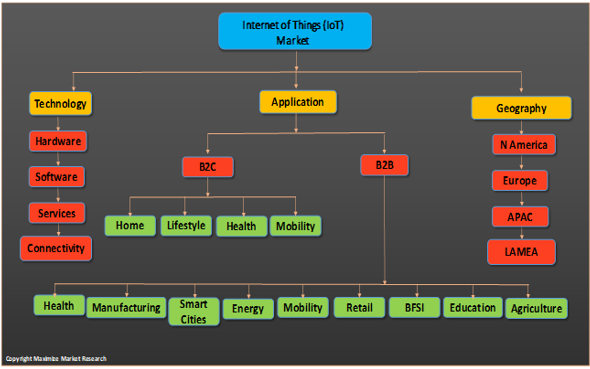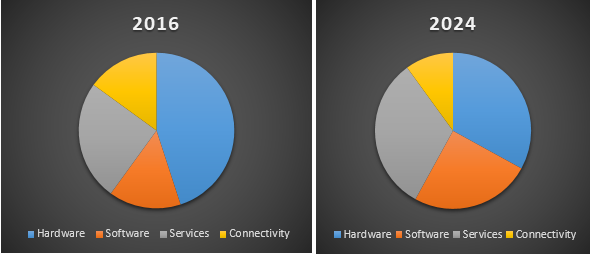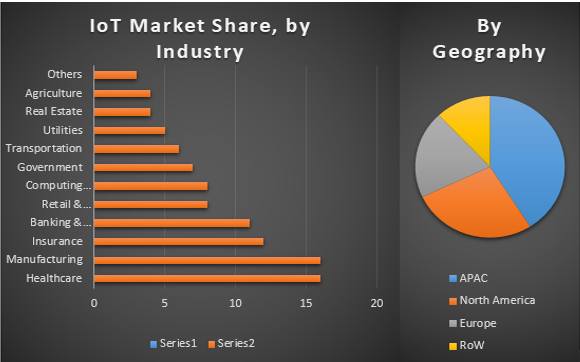Global Internet of Things (IoT) Market is estimated to surpass US$1 Trillion in 2017 and is expected to reach US$ 3.9 Trillion by 2026. The market is projected to register a CAGR of 20.21% during the forecast period 2017-2026 globally.
Consider the scenario – When an alarm of your smartphone rings in the morning, you wake up and tap it to stop the alarm which causes your geyser to be switched on automatically. The smart mirror in your bathroom shows the day’s weather and also indicates the level of water in your overhead tank. After you take some groceries from your refrigerator for makirecognizesst, it recognizes the shortage of stock in it and places an order for the supply of fresh grocery items. When you step out of your house and lock the door, all lights, fans, geysers and AC machines get switched off automatically. On your way to the office, your car warns you about traffic congestion ahead and suggests an alternative route, and if you are late for a meeting, it sends a message to your office accordingly. You also get back to back updates on your cell phone regarding moisture content and soil condition in your farm, rainfall prospects in a mining area and fleet departure data from the site and based on this data you direct your farm labourers, mine workers, and fleet manager respectively. Meanwhile, the continuous glucose monitoring (CGM) system informs you about the glucose levels and gives the diagnosis based on the observations.
The network of physical devices, home appliances, and other items embedded with Software’s, sensors, actuators, electronics and connectivity enabling a form of the free-flowing conversation between man and machine, software and hardware is termed as the internet of things or internet of everything. The modified Coke Machine which was able to report its inventory and whether newly loaded drinks were cold or not is considered as the first internet connected appliance and advancement of internet of things (IoT) is measured thereafter. With the advances in artificial intelligence and machine learning, these conversations can enable devices to anticipate, react, respond and enhance the physical world in much the same way that the internet currently uses networks and computer screens to enhance the world of information. Awareness regarding the IoT’s usage has to be created as the future upcoming generation is going to dive deep in the Internet of Things (IoT) technology making it the inherent part of daily life routine.
Maximize Market Research has carried out extensive research about the current Global Internet of Things (IoT) Market outlook as well as the assuring future of the technology in the sector. The driving forces, as well as considerable restraints have been explained in depth. Report segments Global internet of things (IoT) Market by Technology, Application and Regions, providing the comprehensive analysis of ecosystem of industry, which will be useful to take the informed strategic decision to the stakeholders in the industry. Importantly, the report delivers forecasts of the market, giving an insight into the future opportunities that exist in the Global Internet of Things (IoT) Market.
Global Internet of Things (IoT) Market Ecosystem
Internet of things (IoT) Technology is having a major impact on businesses and consumers alike consequently changing the face of the global economy. Accordingly, 30 Billion Devices are to be connected to the internet by 2020 (World Economic Forum).
Global Internet of Things (IoT) Market is segmented by Hardware, Software, Connectivity Type, Services and Regions providing the thorough understanding of the internet of things (IoT) Ecosystem. Internet of things (IoT) hardware will be the largest technology category followed by services, software and connectivity. By 2026, around 60% of total Internet of things (IoT) spending will be on software and services sgments. The software will also be the fastest growing technology segment led by application software along with analytics software, Internet of things (IoT) platforms, and security software. Services spending will also grow at a faster rate than overall spending and will nearly equal hardware spending by the end of the forecast. Software creates the foundation upon which Internet of things (IoT) applications and use cases can be realized. However, it is the services that help bring all the technology elements together to create a comprehensive solution that will benefit organizations and help them achieve a quicker time to value. Many global Organizations indicate that software and services are the key areas of focused investment for their Internet of things (IoT) projects.
Global Internet of Things (IoT) Market by Application. The research report has emphasized on a complete overview of the Internet of Things (IoT) ecosystem involving its application in innumerable domains e.g. Healthcare, Public Services, Media and Entertainment, Manufacturing, Smart Cities, Home Automation, Education and many others, thus, providing a comprehensive research data. Research report comprehensively analyses all possible industry elements with reference to the utility of Internet of things (IoT). It evaluates all the major global regions based on their economic standings and position in the Global Automotive arena. Further, it gives a studied commentary on the growth prospects of Internet of things (IoT) in coming years and attitude of each industry towards these changes.The driving forces, as well as considerable restraints, have been explained in depth. Further, based on the end user, report segments the market broadly in two categories i.e. Business to Consumer (B2C) and Business to Business (B2B). For the applications where services are directly provided to the consumers (B2C) market is divided between sectors such as Home automation, Lifestyle, Health, Mobility, and Others. Whereas B2B market is distributed between various industries such as Healthcare, Manufacturing, Banking and Finance Services, Insurance, Agriculture, Public Services, Retail & Wholesale and Others. Though The B2B segment is in dominance for the forecast period, the growth prospect of B2C shows the formidable upward trajectory during the same period.
Amongst the industries, Manufacturing, Transportation and Healthcare and Utilities are the fourth runners in spending most on Internet of things (IoT) solutions. IoT spending among manufacturers will be intensively targeted towards solutions supporting manufacturing operations and production asset management. Freight monitoring followed by fleet management occupies nearly two-thirds share of IoT spending in Transportation. Smart grids for electricity, gas, and water will dominate the Utility sector whereas Cross-Industry IoT areas such as connected vehicles and smart buildings, will report formidable growth in the forecast years.
Beyond the Internet of things (IoT)’s economic impact, its effect on society and on the UN’s sustainable development goals (SDGs) is astonishing. Most current Internet of things (IoT) projects can contribute to achieving both the SDGs and the UN’s 2030 mission. 84% of the total existing Internet of things (IoT) deployments can address the SDGs. Interestingly, 75% of these projects concentrate on five SDGs:

Industry, innovation, and infrastructure (25%)
Smart cities and communities (19%)
Affordable and clean energy (19%)
Good health and well-being (7%)
Responsible production and consumption (5%)American Manufacturing giant General Electric, Amazon, DHL, Microsoft, Bosch, Cisco, Symantec and many others are the key players exploring and expanding the scope and reach of Internet of things (IoT). The USP of IoT is the innumerable possibilities it proposes, which are not even realized yet. The impact of Internet of things (IoT) is so comprehensive because at its core about measuring and remotely controlling previously unconnected “things”. It reaches people and objects that older technology could not. From farming to space technology and from routine health check-up to providing information about ozone content in the atmosphere IoT has engulfed each and every aspect of human activity and has become a stellar backbone in a journey towards a ‘Smart Society’. If global regions are taken into consideration, North America. Europe and the Asia Pacific (APAC) will form three key regions contributing to the global demand for Internet of Things (IoT) market.
The Asia Pacific, a dynamic group of rapidly developing economies is expected to grow at the highest rate for Internet of things (IoT) market with the presence of IT industries along is expected to hold the largest market share in forecast years. Rapid digitization along with technological dependency and further advancements have acted as key drivers for the growth of Internet of things (IoT) market in North America. APAC, with the surge in IT infrastructure development acting as some of the major factors to boost overall demand.
In 2018, Asia/Pacific Region will spend more than $300 Billion followed by North America at around $200 billion. Nation wise China carries the baton with around $215 Billion investment in Internet of things (IoT) which is driven by investments from manufacturing, utilities, and government. The USA is following closely with $190 Billion spending led by manufacturing, transportation, and the consumer segment. Japan ($70 billion) and South Korea ($30 billion) will be the third and fourth largest countries in 2018. Looking at the future, Latin America is supposed to deliver fastest overall growth with a CAGR of around 30%.


